Why Zhangjiajie Wulingyuan Should Be on Your China Travel Itinerary
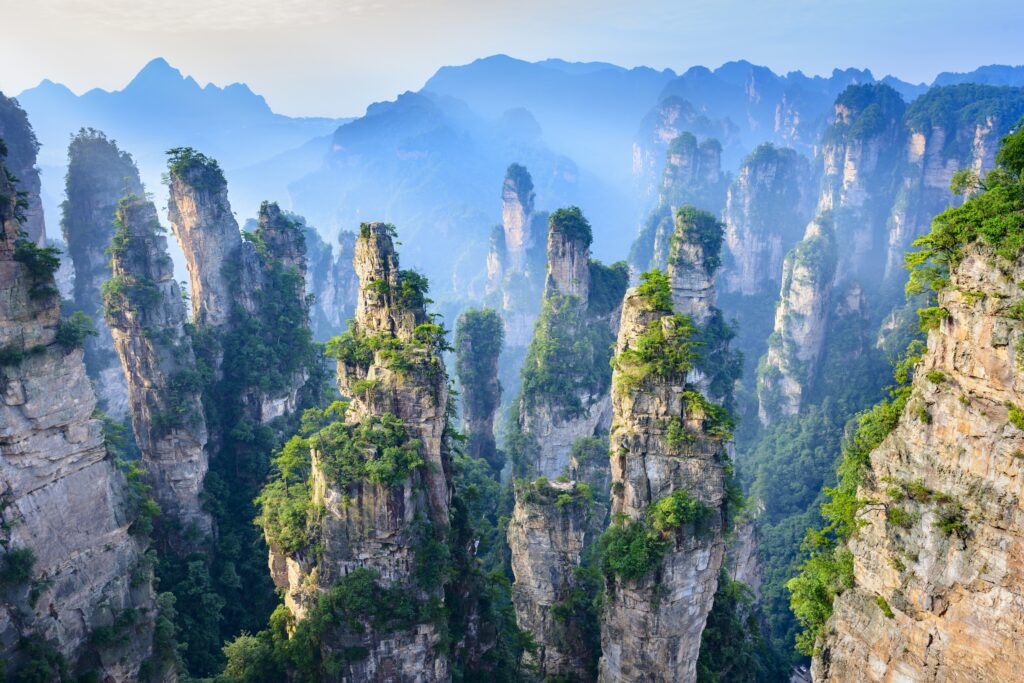
An Essential Guide to Visiting Zhangjiajie Wulingyuan
In This Guide
- An Essential Guide to Visiting Zhangjiajie Wulingyuan
- The Rich History and Legends of Zhangjiajie Wulingyuan
- Main Highlights: What You Absolutely Can’t Miss
- Planning Your Visit: A Practical Guide
- Tickets: Prices, Booking, and Tips
- How to Get There: A Complete Transportation Guide
- Local Cuisine and Accommodation Nearby
- Frequently Asked Questions
- Final Thoughts on Your Trip
Zhangjiajie Wulingyuan, often referred to as the “real-life Pandora,” is a breathtaking natural wonder located in Hunan Province, China. This UNESCO World Heritage Site is renowned for its soaring sandstone pillars, deep ravines, and lush forests that seem to defy gravity. If you’ve ever been captivated by the otherworldly landscapes of the film Avatar, then you understand the allure of this extraordinary destination.
A Tapestry of Natural Beauty and Cultural Significance
The Zhangjiajie National Forest Park, part of the larger Wulingyuan Scenic Area, spans over 11,900 hectares and features more than 3,000 sandstone pillars that rise majestically from the ground, some reaching heights of over 200 meters. These formations were sculpted over millions of years through a combination of erosion and tectonic activity, creating a dramatic landscape that is both awe-inspiring and serene.
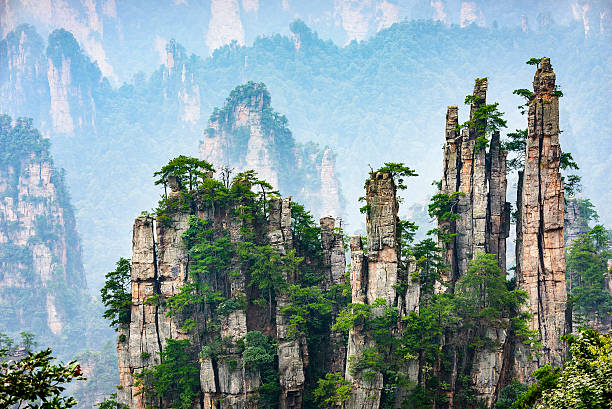
Zhangjiajie Wulingyuan.
But the beauty of Zhangjiajie extends beyond its stunning vistas. This area is steeped in rich history and culture, making it a treasure trove for international travelers eager to explore the depths of Chinese heritage. The local Tujia ethnic minority, who have lived in harmony with these mountains for centuries, offer a glimpse into traditional Chinese life, from their unique customs to their remarkable craftsmanship.
Navigating the Enchantment
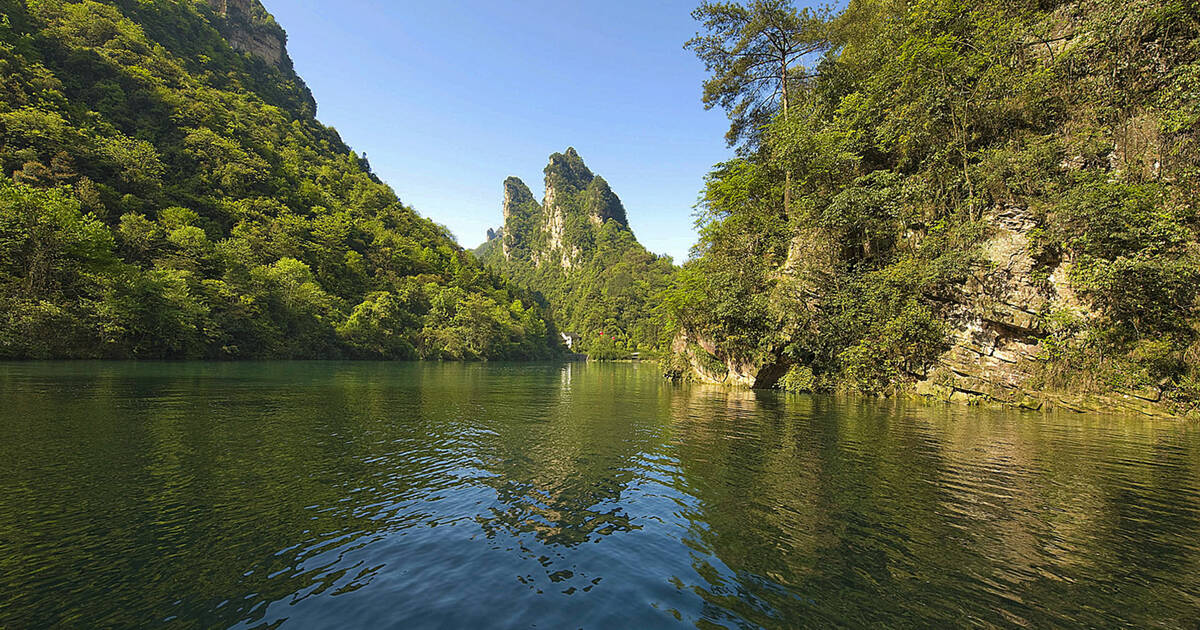
Zhangjiajie Wulingyuan.
Visiting Zhangjiajie Wulingyuan is not merely a sightseeing trip; it’s an immersive experience that invites you to connect with nature and culture in profound ways. With a well-organized system of shuttles, cable cars, and hiking trails, navigating the park is both straightforward and rewarding. You’ll find yourself traversing scenic paths that lead to breathtaking viewpoints, each offering its own unique perspective of the towering pillars and surrounding landscapes.
In this guide, we’ll equip you with essential information to enhance your journey through Zhangjiajie Wulingyuan. From the best times to visit and how to get there, to a carefully crafted itinerary that showcases the park’s highlights, we’ll ensure that you make the most of your adventure. Prepare to be enchanted by the magic of Zhangjiajie, where natural beauty and cultural richness converge to create an unforgettable experience.
The Rich History and Legends of Zhangjiajie Wulingyuan
Zhangjiajie Wulingyuan, a UNESCO World Heritage site, is not only renowned for its breathtaking landscapes but also steeped in a rich tapestry of history and legends that have captured the imaginations of both locals and travelers alike.

Zhangjiajie Wulingyuan.
The Historical Significance of Wulingyuan
The Wulingyuan Scenic Area boasts over 3,000 sandstone pillars, gorges, ravines, and ravishing natural beauty that were formed over millions of years, but its history stretches back to ancient times. The region has been inhabited for thousands of years, with archaeological evidence suggesting that the area was home to various ethnic groups, including the Tujia people, who have lived in harmony with the land for generations.
The name “Wuling” itself is derived from the Wuling Mountains, a range that has served as a natural barrier and has historically been significant in defining the cultural and geographical boundaries of the area. The mountains are mentioned in various historical texts, including the famous Records of the Grand Historian by Sima Qian, where they are described as a sacred place of refuge and a source of inspiration for poets and artists.
Legends that Breathe Life into the Landscape
The Legend of the Heavenly Pillar
One of the most famous legends associated with Zhangjiajie is that of the Heavenly Pillar, also known as the “Avatar Hallelujah Mountain.” According to local folklore, a celestial deity descended from the heavens and planted a powerful tree on this mountain to secure peace and prosperity for the region. The tree eventually transformed into the towering pillar we see today, symbolizing the bond between heaven and earth. This legend resonates deeply with visitors, reminding them of the mystical forces at play in nature.
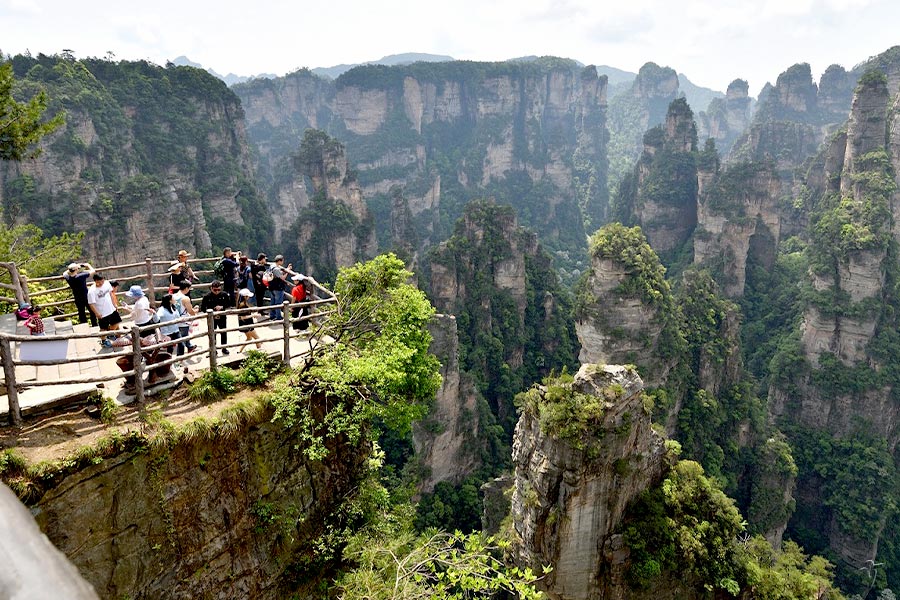
Zhangjiajie Wulingyuan.
The Legend of the Tujia People
The Tujia ethnic group, known for their vibrant culture and traditions, has its own set of legends that enrich the narrative of Wulingyuan. One such tale tells of a valiant warrior who, after defeating an invading army, ascended to the heavens from the peak of Tianzi Mountain, thus earning the title of “Monarch of the Peak Forest.” This legend is not merely a story; it embodies the spirit of resilience and bravery that the Tujia people hold dear to their hearts.
The Love Story of the Fairy and the Mortal
Another poignant legend is the tale of a fairy who fell in love with a mortal man. The couple was separated by the celestial barrier that divided their worlds, and in her despair, the fairy transformed herself into one of the towering pillars. It is said that on quiet nights, one can hear her whispers echoing through the valleys, reminding lovers to cherish their time together. This romantic tale has inspired countless visitors to seek out the area as a destination for love and connection.
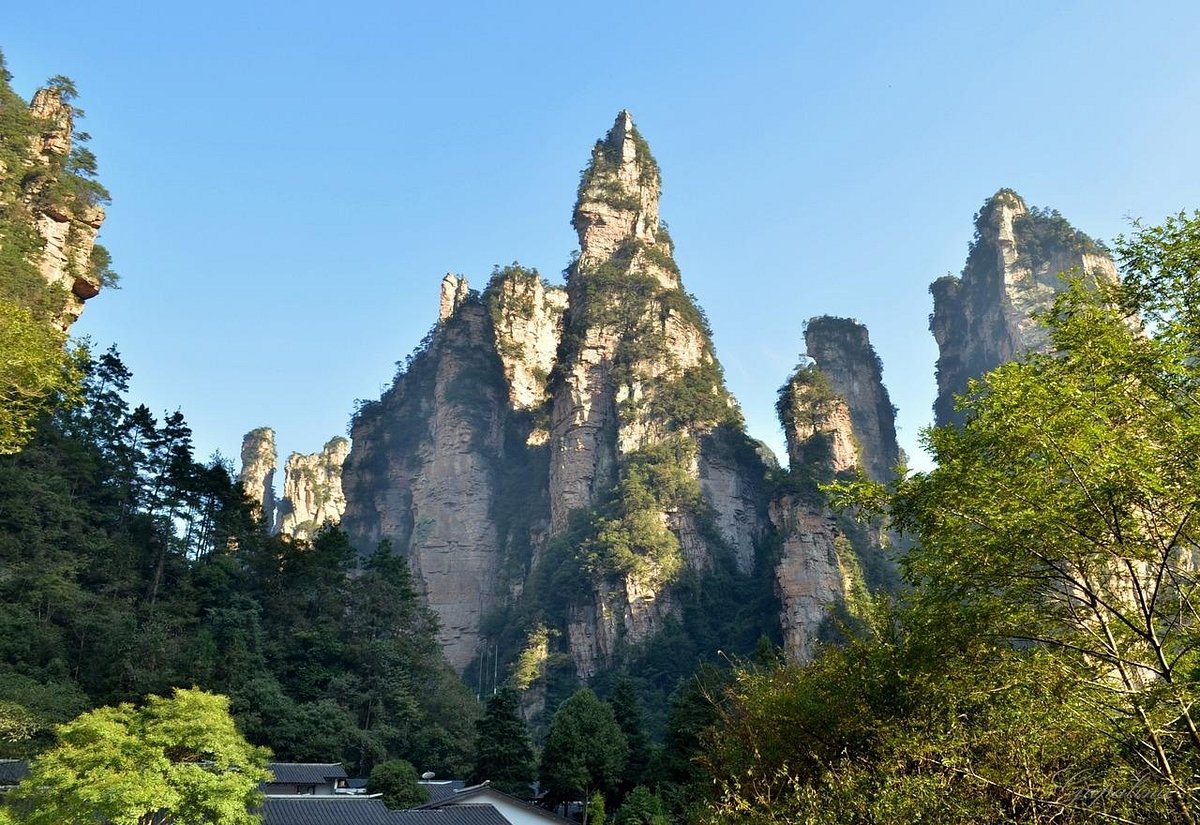
Zhangjiajie Wulingyuan.
Cultural Heritage and Festivals
The legacy of Wulingyuan extends beyond legends into the realm of cultural practices. The Tujia people celebrate numerous festivals throughout the year, such as the Tujia New Year and the Torch Festival, which showcase their rich traditions through dance, music, and culinary delights. Visitors to Zhangjiajie can immerse themselves in these vibrant celebrations, gaining deeper insight into the local culture and the connection the Tujia people have with their stunning surroundings.
Conclusion
As you traverse the majestic landscapes of Zhangjiajie Wulingyuan, take a moment to reflect on the historical significance and the legends that breathe life into this extraordinary place. Each towering pillar and winding gorge tells a story, inviting travelers to connect with the rich cultural heritage that defines this remarkable region. Whether you are an adventurer, a history enthusiast, or a romantic at heart, Wulingyuan promises an enchanting experience that lingers long after your visit.
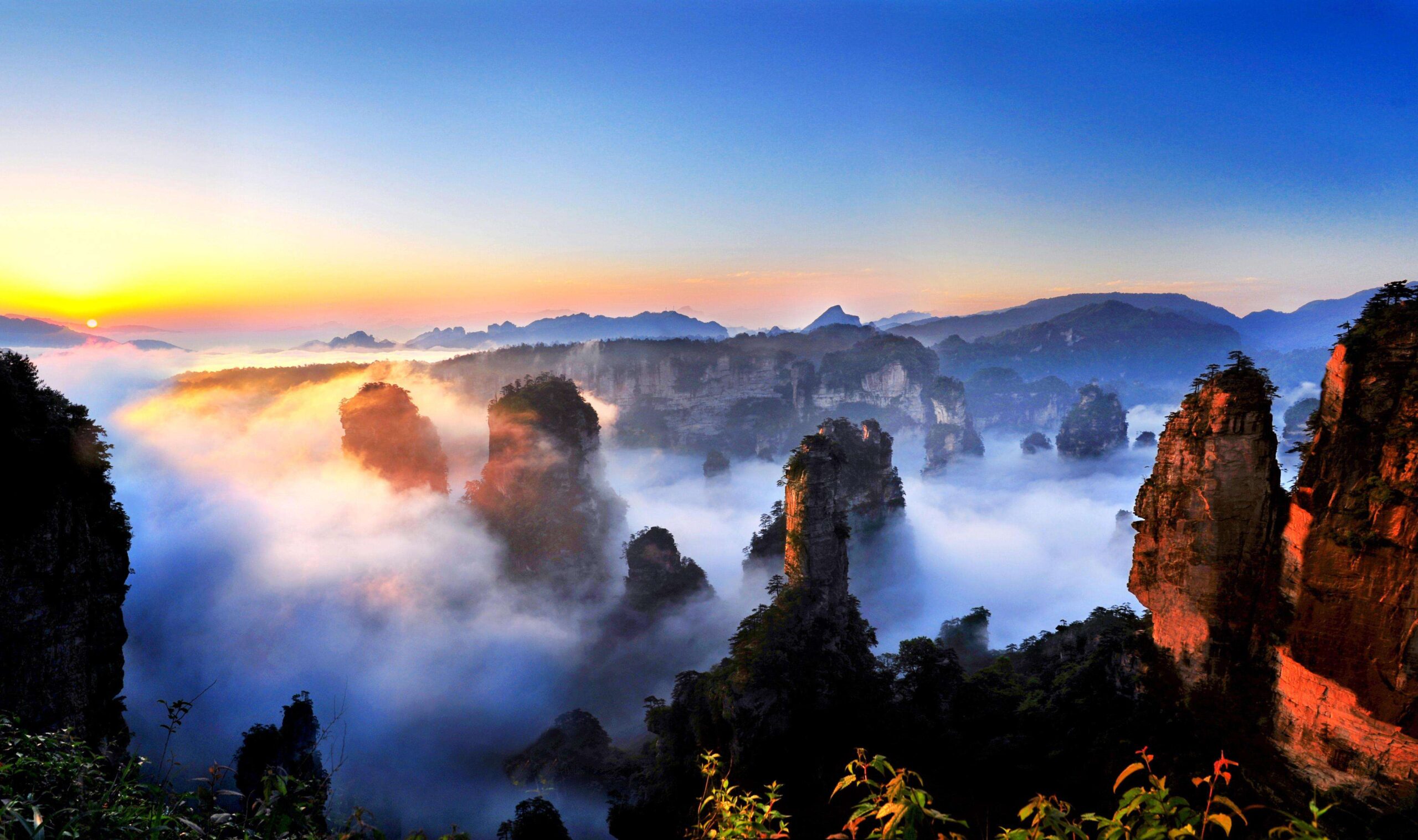
Zhangjiajie Wulingyuan.
Main Highlights: What You Absolutely Can’t Miss
When exploring the magnificent Zhangjiajie Wulingyuan area, there are several highlights that you simply cannot miss. This UNESCO World Heritage site is not only renowned for its breathtaking landscapes, but it also offers a rich tapestry of cultural experiences and natural wonders. Here’s a detailed guide to the must-see attractions that will leave you awe-inspired.
Iconic Landmarks of Zhangjiajie National Forest
1. Yuanjiajie: Avatar Hallelujah Mountains
Arguably the crown jewel of Zhangjiajie, Yuanjiajie is famous for its towering sandstone pillars that inspired the floating mountains in James Cameron’s Avatar. The Heavenly Pillar, soaring 1,080 meters, is a must-see and provides one of the most photographed views in the park. Don’t miss the Greatest Natural Bridge, an archway that connects two cliffs and offers panoramic views of the valley below.
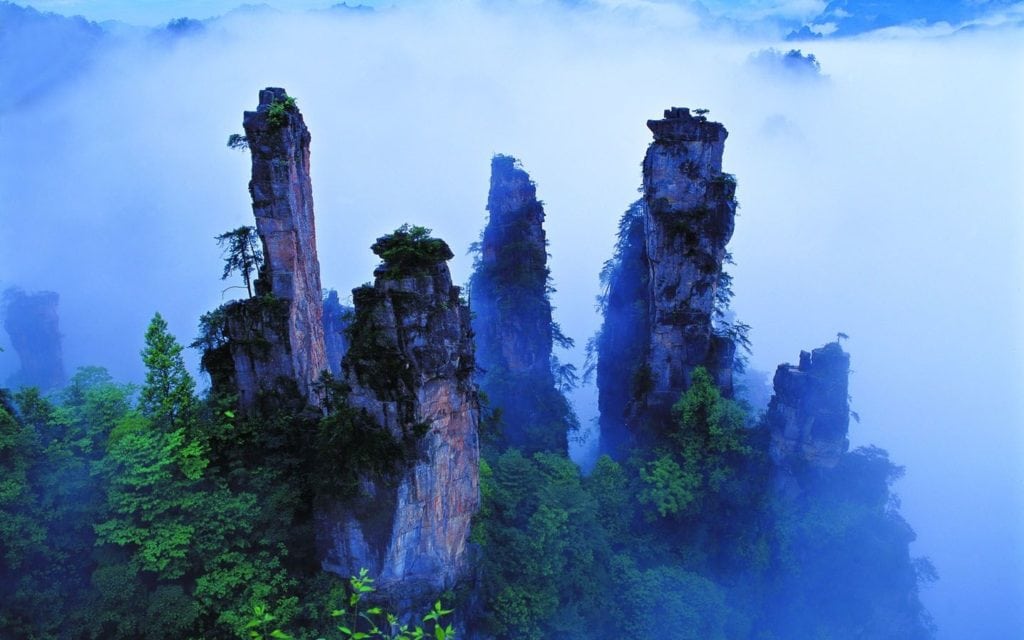
Zhangjiajie Wulingyuan.
Tip: Take the Bailong Elevator, the world’s tallest outdoor lift, for a stunning ascent to the upper platform where the views are simply breathtaking.
2. Yangjiajie: Hidden Trails and Scenic Vistas
For those seeking a quieter experience, Yangjiajie is the perfect spot. This less-trafficked area features serene hiking trails that lead to hidden viewpoints. The One Step to the Heavens spot offers a breathtaking perspective of the surrounding pillars. The tranquility of this section allows you to fully appreciate the natural beauty without the crowds.
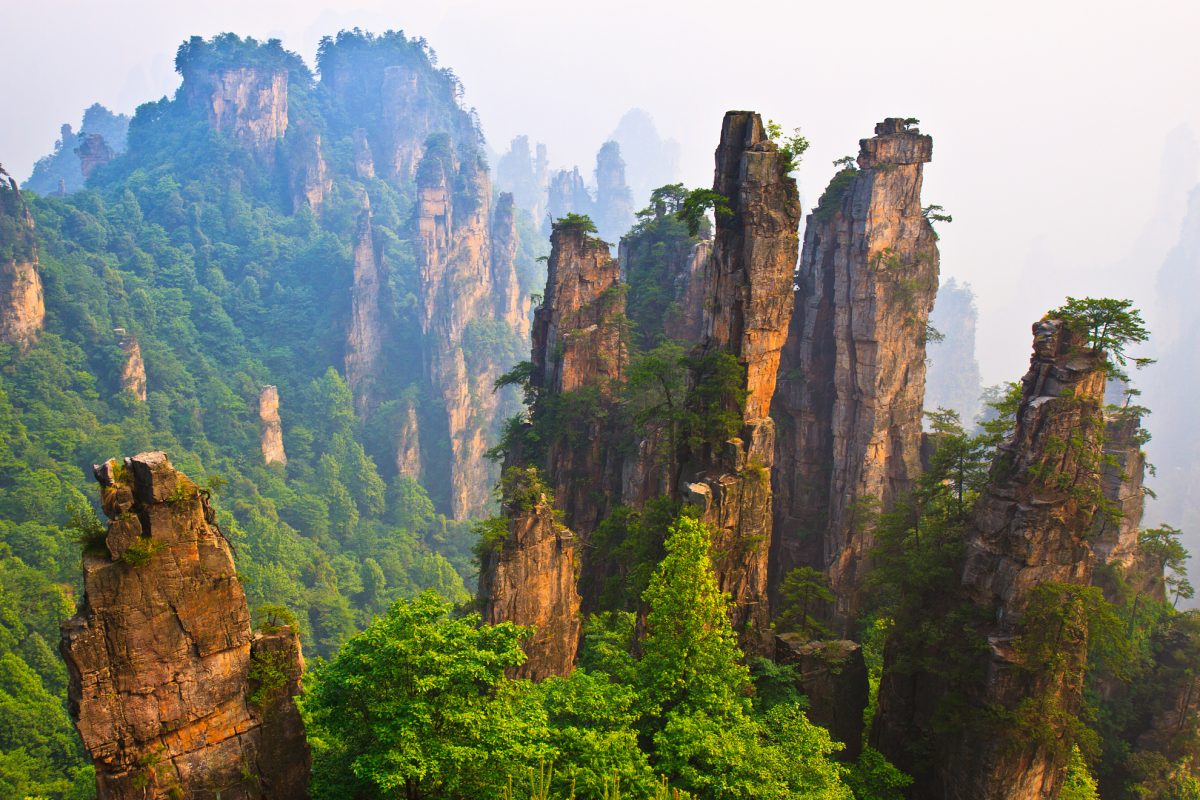
Zhangjiajie Wulingyuan.
Tip: Bring your camera and explore the less obvious paths—many lead to spectacular overlooks and photo opportunities.
3. Tianzi Mountain: Monarch of the Peak Forest
This area is renowned for its unique rock formations and expansive views. The Monarch of the Peak Forest is a towering peak that provides a dramatic backdrop. The panoramic views from Tianzi Mountain are unparalleled, especially during sunrise and sunset.
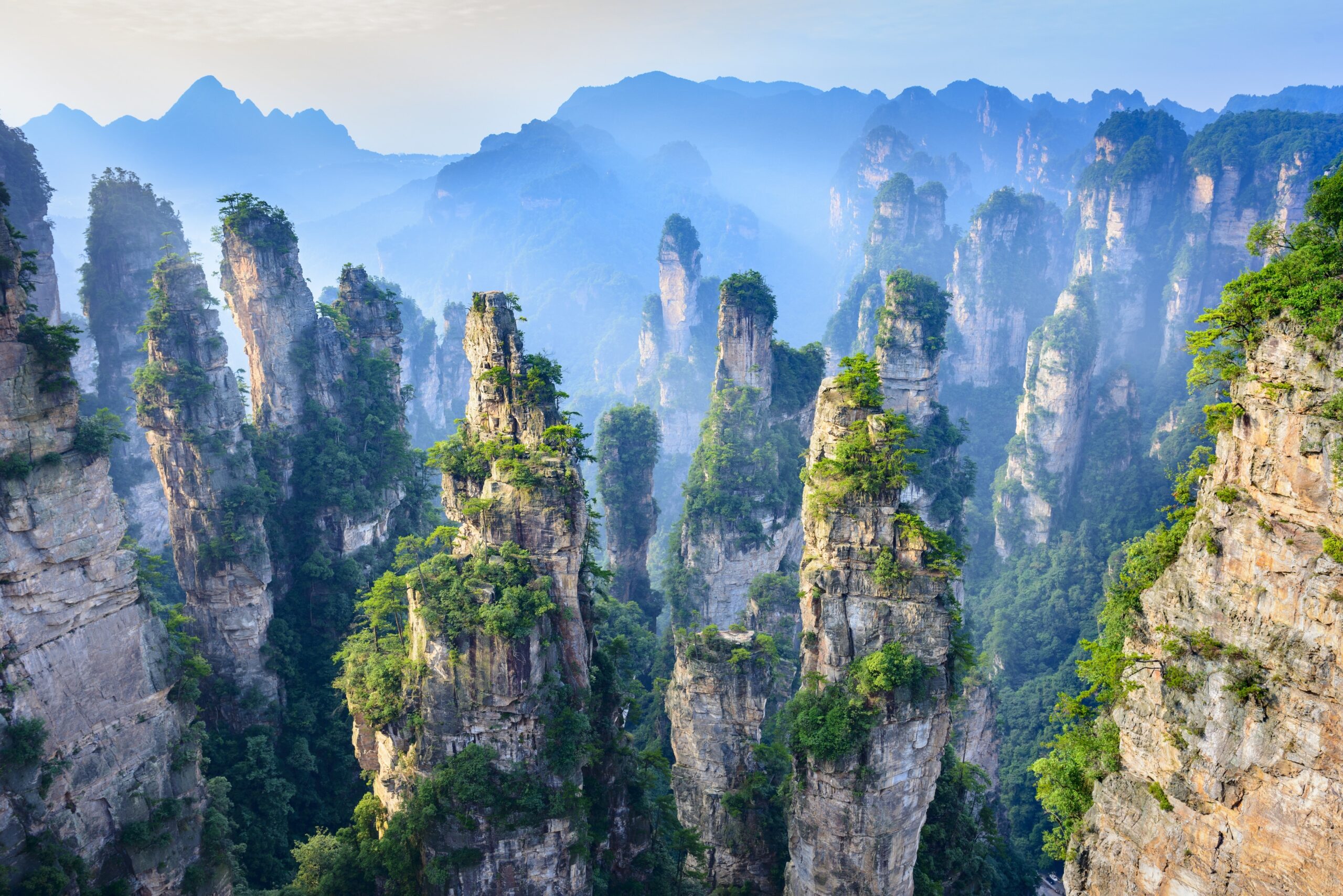
Zhangjiajie Wulingyuan.
Tip: A cable car ride to the summit offers a picturesque journey and a chance to see the forest from above.
4. Huangshi Village: A Natural Viewing Deck
Despite its name, Huangshi Village is not a traditional village but rather a stunning natural observation deck. Standing at an elevation of 1,080 meters, it gives visitors a unique vantage point over the Five Fingers Peak and the surrounding landscape. The area is easily accessible and offers a mix of marked paths and viewing platforms.
Tip: Arrive early to avoid crowds and enjoy the sunrise over the peaks.
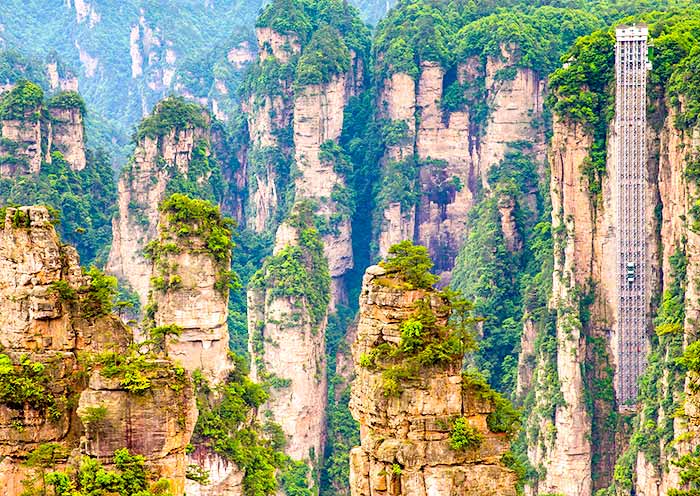
Zhangjiajie Wulingyuan.
5. Golden Whip Stream: A Scenic Valley Walk
Stretching for about 7.5 kilometers, the Golden Whip Stream is a picturesque valley walk that meanders through lush forests and alongside crystal-clear waters. This tranquil path is flanked by towering cliffs and offers a serene escape from the busier areas of the park.
Tip: Bring a picnic and take a break by the stream to soak in the peaceful atmosphere.
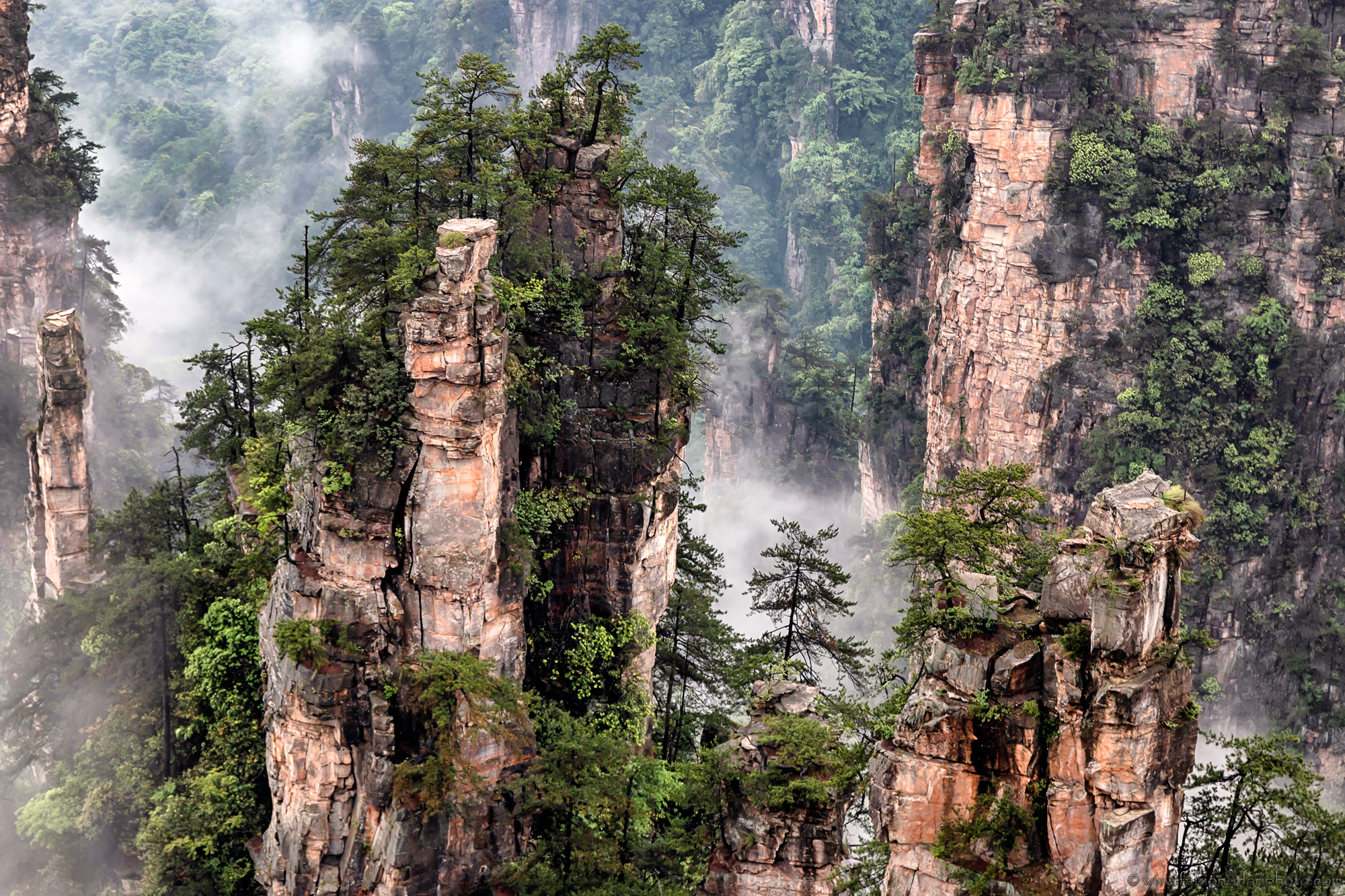
Zhangjiajie Wulingyuan.
6. Ten Mile Gallery: Cultural Insights
This charming trail meanders along the base of the Three Sisters Peaks and is adorned with cultural artifacts and local handicrafts. This area showcases traditional Chinese craftsmanship and provides insight into the local culture.
Tip: Take your time exploring the stalls along the trail, where you can find unique souvenirs to remember your journey.
Practical Tips for Your Visit
- Best Time to Visit: Aim for mid to late fall (October to November) or early spring (March to April) to enjoy mild weather and fewer crowds. Avoid major Chinese holidays for a more peaceful experience.
- Transportation: Utilize the park’s efficient shuttle bus and cable car systems to navigate between the various sections with ease.
- Stay Local: Consider accommodations in Wulingyuan, where you can find a range of options from homestays to resorts, all within walking distance of park entrances.
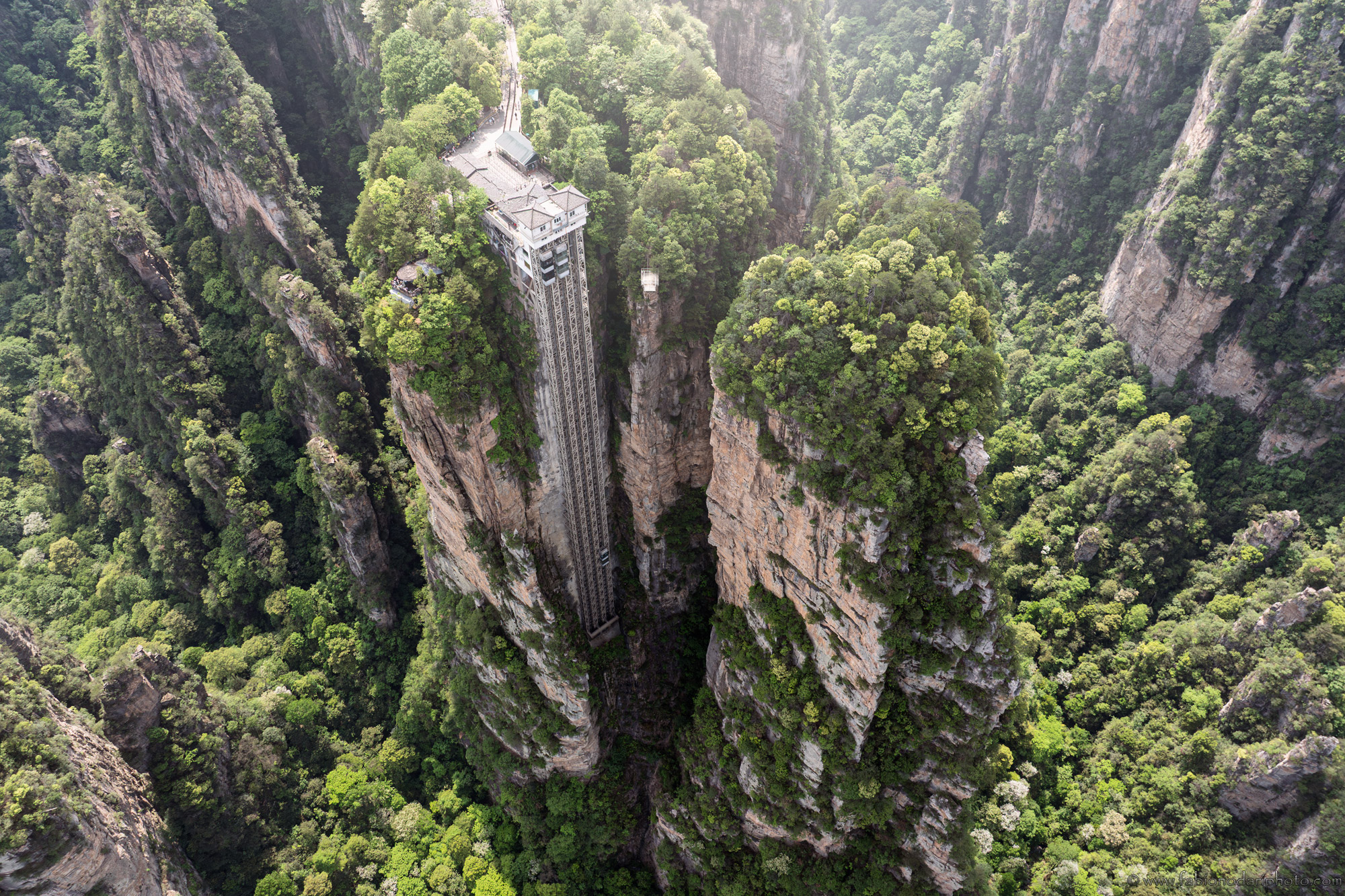
Zhangjiajie Wulingyuan.
Zhangjiajie Wulingyuan is a remarkable destination that seamlessly blends natural beauty with cultural richness. Whether you’re chasing the heights of legendary peaks or wandering through serene valleys, each moment spent here is a step into a breathtaking world that feels almost otherworldly.
Planning Your Visit: A Practical Guide
Your Essential Guide to Visiting Zhangjiajie Wulingyuan
Zhangjiajie Wulingyuan Scenic Area, an enchanting realm of towering sandstone pillars and lush forests, is a must-visit for those interested in China’s breathtaking landscapes and rich cultural heritage. To ensure you navigate this magnificent destination with ease, we’ve compiled a comprehensive practical guide that covers everything from transportation to the best times to visit.
Getting There
To reach Zhangjiajie, you’ll first arrive in Zhangjiajie City, which serves as the gateway to Wulingyuan. Depending on your travel preferences, you can choose between:
-
Train: The Chinese high-speed rail system is highly efficient and offers a scenic ride through Hunan Province. Booking tickets can be done easily through Trip.com, which is particularly user-friendly for international travelers.
-
Flight: If traveling from further afield, consider flying directly into Zhangjiajie Hehua Airport. From the airport, you can take a taxi or shuttle to Wulingyuan, a quaint town where most accommodations are located.
Where to Stay
Wulingyuan offers a variety of accommodation options ranging from affordable homestays to comfortable hotels. Here are a few recommendations:
-
Homestays: For an authentic experience, consider a local homestay within walking distance of the East Entrance to the park.
-
Inns and Hotels: There are numerous inexpensive inns and more upscale options. Look for places that offer easy access to the park entrances.
Best Time to Visit
While Zhangjiajie boasts stunning views year-round, the optimal times for visiting are:
-
Fall (Mid to Late October): Enjoy crisp, clear weather and vibrant autumn colors, with fewer crowds compared to peak seasons.
-
Spring (Early April): Witness the blooming flora and pleasant temperatures. Avoid the major Chinese holidays, such as Golden Week and Chinese New Year, to steer clear of overwhelming crowds.
-
Rainy Season (May to August): While many avoid this time due to potential downpours, those willing to brave the rain can experience the unique misty atmosphere that adds a magical quality to the landscape.
Exploring the Park
Zhangjiajie National Forest Park is vast, and with a 4-day pass, you can explore its many wonders. However, a well-planned 2-day itinerary will allow you to experience the highlights:
Day 1: The Iconic Views
– Yuanjiajie: Begin your journey at the East Entrance and ascend via the Bailong Elevator, the world’s tallest outdoor elevator. Explore the mesmerizing Hallelujah Mountains and snap photos at the Heavenly Pillar.
- Yangjiajie: After Yuanjiajie, venture to this less-visited area for a peaceful hiking experience. The trails offer stunning viewpoints and a chance to escape the crowds.
Day 2: Diverse Perspectives
– Huangshi Village: Start at the South Entrance, where you can enjoy breathtaking views from this natural platform.
-
Golden Whip Stream: Stroll along this picturesque valley trail, flanked by towering cliffs and crystal-clear waters.
-
Ten Mile Gallery: Conclude your visit with a leisurely walk through this scenic area, which features local crafts and cultural experiences.
Tips for a Memorable Experience
- Plan Ahead: Download maps and translation apps to facilitate communication and navigation.
- Stay Hydrated and Snack Smart: Bring water and snacks, especially if you plan to hike. Local shops offer refreshments, but it’s wise to come prepared.
- Capture the Moment: Bring a good camera or smartphone to capture the breathtaking views. Consider a lightweight drone for aerial perspectives, but ensure you comply with local regulations.
- Engage with Locals: Don’t hesitate to interact with local guides and residents; their insights can greatly enhance your visit.
With this guide, you are now equipped to make the most of your adventure in Zhangjiajie Wulingyuan. Embrace the stunning scenery, immerse yourself in the local culture, and create memories that will last a lifetime!
Tickets: Prices, Booking, and Tips
When planning your adventure to Zhangjiajie Wulingyuan, understanding the ticketing system, pricing, and booking options is essential for a smooth experience. Here’s everything you need to know to make the most of your visit to this breathtaking national treasure.
Ticket Options and Prices
Zhangjiajie National Forest Park offers several ticket options tailored to different needs:
-
Single-Day Ticket: Approximately ¥245 (about $38 USD). This ticket grants you access to the park for one day and covers entry to all main areas.
-
Four-Day Pass: Approximately ¥315 (about $49 USD). Ideal for those wanting to explore every nook and cranny of the park, this pass allows access over four consecutive days and is a great option for travelers wishing to take their time.
-
Bailong Elevator Ticket: This iconic elevator ride, which offers stunning views, costs around ¥75 (about $12 USD) for a round trip. It’s worth every yuan for the unforgettable experience as you ascend the towering sandstone pillars.
-
Cable Car Tickets: Prices vary depending on the route, generally ranging from ¥60 to ¥90 (about $9 to $14 USD). These cable cars provide another breathtaking viewpoint and are highly recommended.
Booking Your Tickets
To ensure a hassle-free visit, it’s advisable to purchase your tickets in advance. Here are the best methods:
-
Online Booking: For international travelers, Trip.com is the most user-friendly platform. It allows you to book train tickets and park entries without needing a Chinese residence card. This site is particularly helpful for navigating the complexities of domestic travel in China.
-
On-Site Purchase: While you can buy tickets at the park entrance, be prepared for long lines, especially during peak tourist seasons. If you choose this route, aim to arrive early to beat the crowds.
-
Travel Agencies: Consider using a local travel agency, which can provide packages that include transportation, accommodations, and guided tours, making your visit even more seamless.
Tips for a Smooth Experience
-
Visit During Off-Peak Seasons: To avoid the overwhelming crowds, plan your visit in mid to late fall (October to November) or early spring (March to April). Avoid major Chinese holidays like Golden Week and Chinese New Year, when the park can become extremely congested.
-
Group Discounts: If you’re traveling with a group, check for group ticket discounts. Many parks in China offer reduced rates for larger parties.
-
Cash and WeChat Pay: While many places accept credit cards, it’s wise to have cash on hand for smaller purchases. Additionally, WeChat Pay is widely used in China, making it a convenient option for transactions.
-
Plan Your Itinerary: With the vastness of Zhangjiajie National Forest Park, having a detailed itinerary can help you maximize your experience. Consider a two-day plan to explore the most famous sights, balancing between popular viewpoints and lesser-known trails.
By understanding ticket options, booking methods, and practical tips, you can focus on what truly matters—immersing yourself in the awe-inspiring landscapes of Zhangjiajie, a true wonder of nature. Enjoy your journey through this enchanting realm that inspired the world of Avatar!
How to Get There: A Complete Transportation Guide
Reaching Zhangjiajie Wulingyuan: Your Complete Transportation Guide
Zhangjiajie, with its ethereal landscapes and the iconic sandstone pillars that inspired the floating mountains of Avatar, is one of China’s most extraordinary destinations. However, getting there requires a bit of planning. Here’s your comprehensive guide to navigate your way to this breathtaking location with ease.
Getting to Zhangjiajie City
By Air
The most convenient way to reach Zhangjiajie is through Zhangjiajie Hehua Airport (DYG), which is well-connected to major cities in China, including Beijing, Shanghai, and Guangzhou. Flights into Zhangjiajie are frequent but can vary in availability, especially during peak travel seasons.
Tips for Booking Flights:
– Use Reliable Platforms: For international travelers, platforms like Trip.com are recommended for booking domestic flights as they simplify the process and often offer better navigation than many Chinese airline websites.
– Book in Advance: To secure the best rates, especially during busy holiday periods, book your flights well in advance.
By Train
China’s high-speed rail network is another excellent option. Zhangjiajie Railway Station connects to several major cities, with fast trains providing a comfortable and scenic journey. The ride can be particularly enjoyable, offering glimpses of stunning landscapes along the way.
Tips for Train Travel:
– Purchase Tickets Online: Again, Trip.com is invaluable for foreign travelers looking to book train tickets without needing a Chinese residence card.
– Check Train Schedules: Popular routes can fill up quickly, so checking schedules and booking ahead is wise.
From Zhangjiajie City to Wulingyuan
Upon arriving in Zhangjiajie City, your next step is to reach Wulingyuan, the charming gateway town to the Zhangjiajie National Forest Park.
By Bus:
The most straightforward and economical option is to take a local bus from Zhangjiajie City to Wulingyuan. Buses are frequent, and the journey takes about 30 minutes. Simply head to the Zhangjiajie Bus Station, where you can find direct buses to Wulingyuan.
By Taxi or Ride-Hailing Apps:
For a more comfortable and direct route, consider taking a taxi or using ride-hailing apps like Didi. This is particularly convenient if you are traveling with a group or have significant luggage.
Accommodation Tip:
Wulingyuan offers various accommodation options, from budget homestays to comfortable resorts. Staying here provides easy access to the East Entrance of the Zhangjiajie National Forest Park.
Navigating Zhangjiajie National Forest Park
Once you’ve settled in Wulingyuan, getting around the national park is relatively easy, thanks to its well-organized transportation system.
Park Shuttle Buses:
The park is equipped with a reliable shuttle bus service that connects the main attractions. After entering through the East Entrance, you can catch a shuttle to various sites, including the famous Bailong Elevator, which takes you up to the breathtaking Yuanjiajie area.
Cable Cars:
In addition to shuttle buses, there are cable cars available that provide stunning aerial views of the park as you ascend to key vantage points. This is a must-do for photographers and nature lovers alike.
Walking Trails:
The park is designed for exploration on foot, with numerous walking trails that lead to spectacular viewpoints. Don’t hesitate to wander; each path offers unique perspectives of the towering pillars and lush landscapes.
Best Time to Visit
While Zhangjiajie is a year-round destination, the best times to visit are during spring (April to June) and fall (September to November). These seasons offer moderate weather and fewer crowds, allowing you to fully enjoy the park’s serene beauty. Be wary of the Chinese holidays, particularly the Golden Week in early October and Chinese New Year, as these times can bring overwhelming crowds.
Conclusion
Reaching Zhangjiajie Wulingyuan and exploring its stunning national park is a journey worth every effort. With careful planning and the right transportation choices, you can immerse yourself in one of China’s most enchanting landscapes. Prepare to be awed by nature and inspired by the adventure that awaits!
Local Cuisine and Accommodation Nearby
Discovering Local Flavors and Comfortable Stays in Wulingyuan
As you embark on your journey through the breathtaking landscapes of Zhangjiajie Wulingyuan, don’t overlook the delightful culinary experiences and accommodations that await you in the nearby town of Wulingyuan. This quaint town serves as the perfect gateway to the national park, offering a blend of local flavors and cozy lodgings to enhance your travel experience.
Savor Local Cuisine
Wulingyuan is home to a variety of dining options that highlight the rich culinary traditions of Hunan Province. Here are some local dishes and restaurants you shouldn’t miss:
-
Spicy Fish Head Stew
A must-try dish that embodies the bold flavors of Hunan cuisine. The fish head is simmered in a spicy broth, seasoned with fresh herbs and chili, creating a dish that is both flavorful and aromatic. Look for this dish at local restaurants, such as Wulingyuan Fish Head Restaurant, where locals flock for its authentic taste. -
Preserved Vegetables
Hunan is renowned for its preserved vegetables, often served as a side dish. They add a delightful crunch and tanginess to any meal. Visit Hunan Flavor Restaurant, where you can sample a variety of these delightful pickled treats alongside your main course. -
Stir-Fried Wild Mushrooms
For a taste of the region’s natural bounty, try the stir-fried wild mushrooms, which are often foraged from the surrounding forests. Zhangjiajie Mountain View Restaurant is known for its delicious rendition, prepared with local herbs and spices. -
Chili Oil Dishes
Hunan cuisine is famous for its liberal use of chili oil. Dishes like Chili Chicken or Spicy Tofu will set your taste buds ablaze. Head to Wulingyuan Local Kitchen to experience the authentic heat of Hunan dining. -
Street Food Delights
Don’t miss out on street food vendors offering snacks like stinky tofu and sweet potato balls. These quick bites are perfect for fueling your adventures in the park.
Where to Stay
Accommodations in Wulingyuan range from charming homestays to comfortable hotels, all conveniently located for easy access to Zhangjiajie National Forest. Here are some recommendations:
-
Homestay Options
For a more intimate experience, consider staying at a local homestay like Zhangjiajie Wulingyuan Homestay. This cozy property is within walking distance of the East Entrance to the park and offers comfortable rooms with traditional decor. The owners often provide insider tips on exploring the area. -
Budget-Friendly Inns
If you’re looking for something affordable yet comfortable, Wulingyuan Inn is a great choice. It provides clean accommodations at reasonable rates, with friendly staff who are eager to assist you in planning your visits to the park. -
Mid-Range Hotels
For a bit more comfort, Zhangjiajie Wulingyuan Hotel features modern amenities and stunning views of the surrounding mountains. Enjoy a hearty breakfast at their on-site restaurant before setting off for your day of exploration. -
Luxury Stays
If you’re in the mood to indulge, consider Pullman Zhangjiajie, a luxurious hotel that offers spacious rooms, a spa, and fine dining. It’s a perfect retreat after a day of hiking and exploring the national park.
Wulingyuan is not only the gateway to one of China’s most spectacular natural wonders but also a hub of local culture and cuisine. Immerse yourself in the flavors of Hunan and find a comfortable place to rest your head as you create unforgettable memories in Zhangjiajie.
Frequently Asked Questions
Frequently Asked Questions
1. How do I get to Zhangjiajie Wulingyuan?
To reach Zhangjiajie Wulingyuan, you can fly into Zhangjiajie Hehua Airport or take a train to Zhangjiajie City. From there, local buses or taxis can take you to Wulingyuan, the charming gateway town to the national park. Booking tickets through platforms like Trip.com is highly recommended for foreign travelers.
2. What is the best time to visit Zhangjiajie?
The ideal time to visit Zhangjiajie is during mid to late fall (September to November) or early spring (March to April). These seasons offer pleasant weather, fewer crowds, and stunning landscapes. Avoid major Chinese holidays such as Golden Week (first week of October) and Chinese New Year (dates vary) for a more serene experience.
3. How long should I plan to spend in the park?
While you can purchase a 4-day pass to explore all areas of Zhangjiajie National Forest, a well-planned 2-day itinerary is sufficient to see the main attractions. This allows you to experience highlights like Yuanjiajie, Yangjiajie, and Tianzi Mountain, along with scenic walks along the Golden Whip Stream.
4. What are the main attractions within Zhangjiajie National Forest?
The park features several stunning sections:
– Yuanjiajie: Home to the famous Avatar Hallelujah Mountains.
– Yangjiajie: A less crowded area with beautiful hiking trails.
– Tianzi Mountain: Offers breathtaking vistas and unique rock formations.
– Huangshi Village: A natural viewpoint with sweeping views.
– Golden Whip Stream: A picturesque valley walk.
– Ten Mile Gallery: A trail showcasing local crafts and culture.
5. What should I wear and bring for my visit?
Dress comfortably and in layers, as weather can change quickly. Good hiking shoes are essential for exploring the trails. Bring a water bottle, snacks, sunscreen, and a camera to capture the stunning views. A light rain jacket may also be handy, especially during the rainy season from May to August.
6. Are there any guided tours available?
Yes, various guided tours are available, ranging from group excursions to private guides. These tours can enhance your experience by providing valuable insights about the park’s history, geology, and local culture. Alternatively, you can explore independently using detailed maps and itineraries.
7. Is it easy to navigate the park?
Zhangjiajie National Forest is equipped with a reliable shuttle bus system and well-marked trails, making navigation straightforward. However, it’s advisable to carry a map or use a translation app to communicate with local staff if needed.
8. What are some unique cultural experiences in Zhangjiajie?
In addition to the stunning natural scenery, visitors can immerse themselves in local culture by visiting nearby villages or markets. Enjoy traditional Hunan cuisine, and consider exploring local handicrafts at the Ten Mile Gallery. The park also features areas adorned with red fortune ribbons, offering a glimpse into local customs and beliefs.
Final Thoughts on Your Trip
As you prepare to depart from the enchanting landscapes of Zhangjiajie Wulingyuan, it’s essential to reflect on the profound experiences you’ve gathered amidst the towering quartz-sandstone pillars that have inspired awe for centuries. This UNESCO World Heritage site is not just a visual feast but a cultural tapestry woven with stories of nature, history, and local traditions.
A Journey Beyond Imagery
Your adventure here has undoubtedly been marked by breathtaking views and exhilarating hikes. Yet, the true essence of Zhangjiajie lies beyond its stunning vistas. With every step along the trails, you’ve walked in the footsteps of ancient sages, experienced the tranquility of the Golden Whip Stream, and marveled at the spiritual significance of the natural wonders. This place serves as a reminder of the harmony between humanity and nature—a theme that resonates deeply within Chinese culture.
Cultural Connections
Engaging with local artisans at the Ten Mile Gallery and tasting the flavors of Hunan cuisine offer a glimpse into the region’s rich heritage. Don’t forget to take a piece of this experience home with you—whether it’s a handcrafted souvenir or a cherished recipe. By immersing yourself in the cultural fabric of Zhangjiajie, you’ve forged connections that transcend borders.
Final Reflections
As you leave, consider the moments that moved you—those breathtaking sunrises, the exhilarating rides on the Bailong Elevator, or the serene quiet of Yangjiajie away from the crowds. Take these memories with you, and let them inspire further exploration of China’s vast and varied landscapes.
Zhangjiajie is a destination that invites you to return, offering new adventures and insights with every visit. So, as you close this chapter, keep your heart open to the wonders that await in your next journey, whether in the hidden corners of China or elsewhere around the globe. Safe travels!